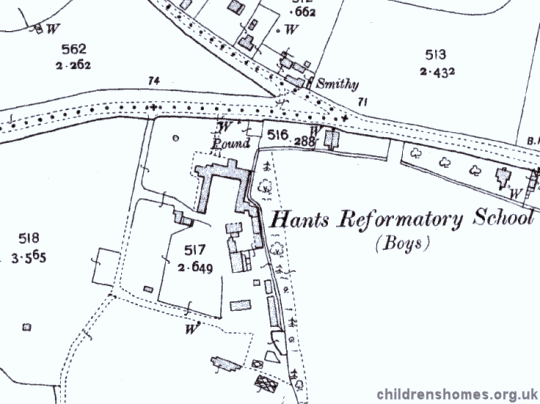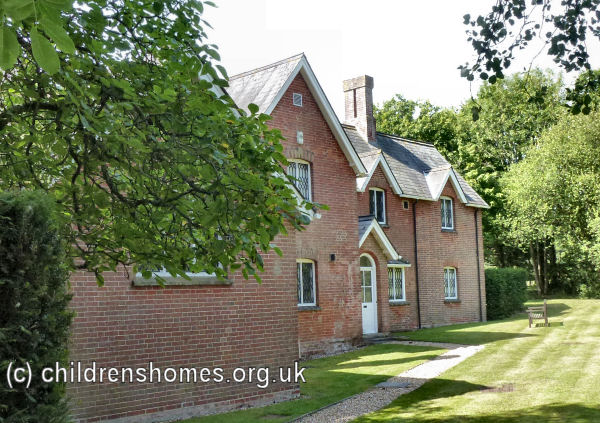Hants Reformatory for Boys, Netley Marsh, Eling, near Southampton, Hampshire
The Hants (i.e. Hampshire) Reformatory School for Boys was founded by Mr H.C. Thompson and came into operation in May, 1855. It was located at Netley Marsh, near Totton, in the parish of Eling, Southampton. Its premises, rented from Mr Compton, consisted of a farm-house, adapted and extended for the purpose, together with twenty acres of farmland. On November 29th, 1855, the School was formally certified to accommodate boys, aged 12 to 15, committed by magistrates to a period of detention.
In 1858, a new dormitory, 36 feet in length was erected, with workshops underneath. A cell was also provided in which a miscreant could be confined. In 1860, a new schoolroom was added.
In September 1860, the then Master, Mr Williams resigned after some deficiencies were discovered in his keeping of the School's accounts. His replacement was Mr William Harold, who had been master of the Leicestershire Reformatory until its closure in 1861. His wife, Susannah, took on the post of the School's matron.
Between nine and ten o'clock in the evening of Friday 11th October, 1867, a fire — believed to have started accidentally — destroyed a large part of the School buildings. The boys, who had already retired to their beds, were immediately aroused, and exertions made to save the furniture and other articles. In the meantime, a messenger was despatched on horseback to Southampton to summon fire engines, and two — the Royal and the borough — were despatched. After arriving at the scene, water was drawn from some wells nearby, which were soon emptied of their contents, and water then had to obtained from two ponds some considerable distance away. The main building was completely gutted, although some of the other accommodation was saved. The boys took refuge in nearby cottages and the local vicar took charge of around twenty of them. Many of the boys were heard to lament that they had lost things in the shape of prizes, etc. awarded to them for good conduct. It was fortunate that the fire did not break out later in the evening, or would probably have resulted in far more serious consequences.
Replacement buildings, completed in 1868 at a cost of £600, included a large and well-ventilated dormitory, with kitchen and other facilities underneath, and a separate residence for the superintendent.
The location of the School is shown on the 1909 map below.

Hants Reformatory for Boys site, Netley Marsh, Southampton, c.1909.

Former Hants Reformatory from the north-east, 2015.© Peter Higginbotham
The chief form of industrial training provided for the boys was working the School's farmland which by 1890 had been increased to 36 acres. Livestock including cows, pigs and poultry. There was also a large and well cultivated garden. Other activities included carpentry, tailoring and shoemaking. The boys made their own clothing, boots and shoes, and baked their own bread. In the winter, the boys were also occupied in wood chopping and faggot making. It was said that the School's former inmates made good soldiers and did well in the colonies.
From 1877, following the death of their mother, the Harolds' daughters Maud and Alice, took on the role of the School matron. Their eldest son, also called William, was an assistant at the School. In around 1895, William Junior and his wife Emily took over as master and matron of the School.
By the early 1900s, a decline in numbers being committed to the School was causing difficulties and in 1907 it was described as "languishing". The School finally closed at the end of September, 1908. The former School premises, later called Marley House, are now in commercial use and known as Carlton House.
Records
Note: many repositories impose a closure period of up to 100 years for records identifying individuals. Before travelling a long distance, always check that the records you want to consult will be available.
- None identfied at present — any information welcome.
Bibliography
- Carpenter, Mary Reformatory Schools, for the Children of the Perishing and Dangerous Classes, and for Juvenile Offenders (1851, General Books; various reprints available)
- Carlebach, Julius Caring for Children in Trouble (1970, Routledge & Kegan Paul)
- Higginbotham, Peter Children's Homes: A History of Institutional Care for Britain's Young (2017, Pen & Sword)
- Abel Smith, Doroth Crouchfield: A History of the Herts Training School 1857-1982 (2008, Able Publishing)
- Garnett, Emmeline Juvenile offenders in Victorian Lancashire: W J Garnnett and the Bleasdale Reformatory (2008, Regional Heritage Centre, Lancaster University)
- Hicks, J.D. The Yorkshire Catholic Reformatory, Market Weighton (1996, East Yorkshire Local History Society)
- Slocombe, Ivor Wiltshire Reformatory for Boys, Warminster, 1856-1924 (2005, Hobnob Press)
- Duckworth, J.S. The Hardwicke Reformatory School, Gloucestershire (in Transactions of the Bristol and Gloucestershire Archaeological Society, 1995, Vol. 113, 151-165)
Links
- Red Lodge Museum, Bristol — a former girls' reformatory.
Except where indicated, this page () © Peter Higginbotham. Contents may not be reproduced without permission.


